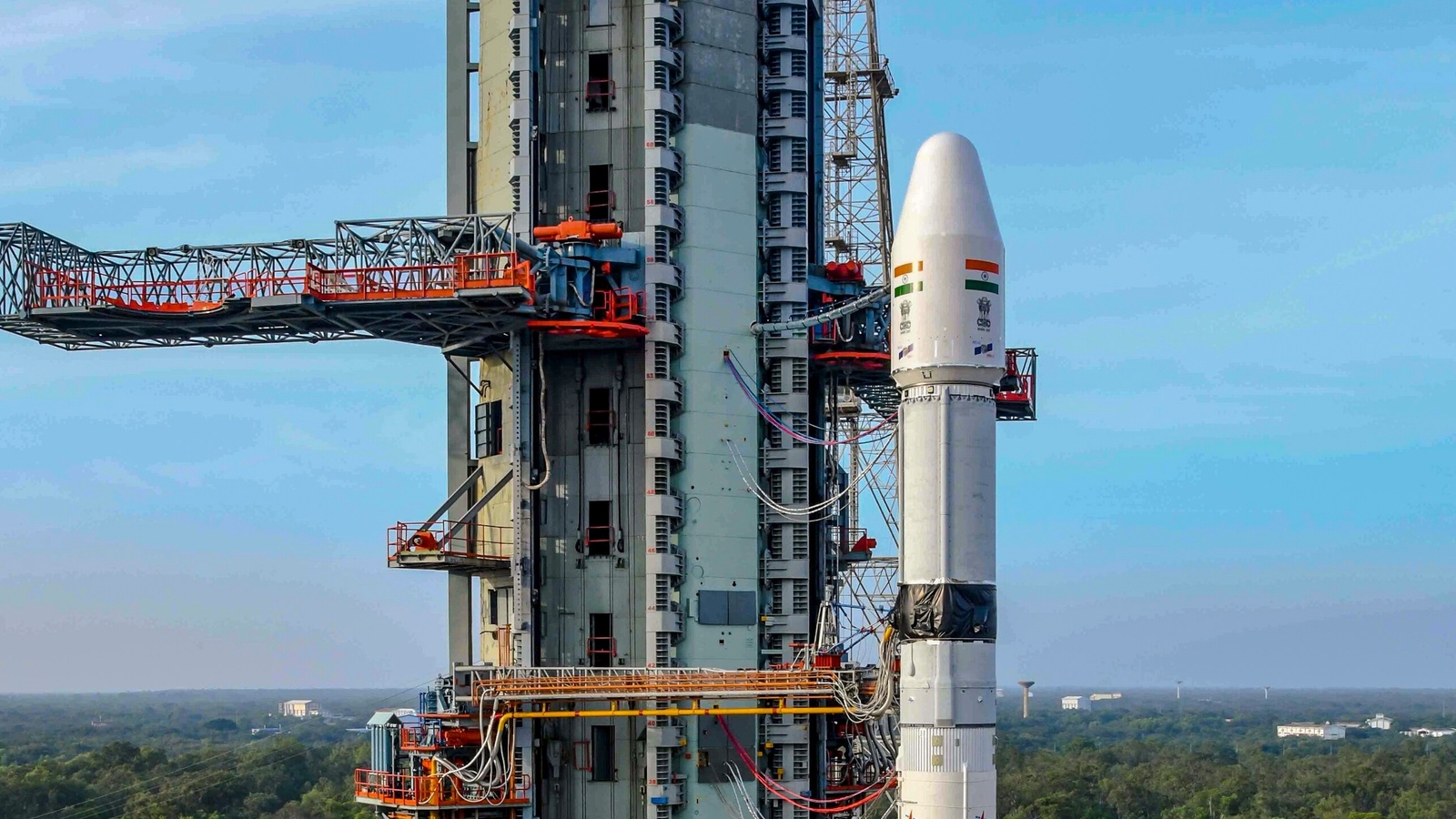- Courses
- GS Full Course 1 Year
- GS Full Course 2 Year
- GS Full Course 3 Year
- GS Full Course Till Selection
- Answer Alpha: Mains 2025 Mentorship
- MEP (Mains Enrichment Programme) Data, Facts
- Essay Target – 150+ Marks
- Online Program
- GS Recorded Course
- Polity
- Geography
- Economy
- Ancient, Medieval and Art & Culture AMAC
- Modern India, Post Independence & World History
- Environment
- Governance
- Science & Technology
- International Relations and Internal Security
- Disaster Management
- Ethics
- NCERT Current Affairs
- Indian Society and Social Issue
- NCERT- Science and Technology
- NCERT - Geography
- NCERT - Ancient History
- NCERT- World History
- NCERT Modern History
- CSAT
- 5 LAYERED ARJUNA Mentorship
- Public Administration Optional
- ABOUT US
- OUR TOPPERS
- TEST SERIES
- FREE STUDY MATERIAL
- VIDEOS
- CONTACT US
ISRO’s 100th mission from Sriharikota
ISRO’s 100th mission from Sriharikota
07-03-2025

- In January 2025, the Indian Space Research Organisation (ISRO) launched NVS-02, marking the 100th successful launch in its history.
- The GSLV (Geosynchronous Satellite Launch Vehicle)-F15 rocket carried the NVS-02 navigation satellite into orbit, signaling a major step in India’s space program.
What is NVS-02?
- NVS-02 is the second satellite in a series of five next-generation satellites that are part of India’s Indian Regional Navigation Satellite System (NavIC).
- This series is designed to replace the existing satellites in the NavIC constellation.
- The first satellite of this series was launched in 2023, and NVS-02 continues to enhance the capabilities of the system.

Key Features of NVS-02:
- Enhanced Satellite Capabilities: NVS-02, compared to its predecessors, is heavier, has a longer mission life, and is equipped with advanced technology, including indigenously developed atomic clocks.
- L1 Frequency: A significant feature of the NVS-02 is its support for the L1 frequency, which is widely used by the U.S. Global Positioning System (GPS). This enhancement allows NavIC signals to be more accessible, even for smaller devices like personal trackers.
Payloads of NVS-02
NVS-02 have two main types of payloads: navigation payload and ranging payload, each serving a distinct purpose in providing accurate location and time data.
1. Navigational Payload:
- Transmission of Signals: The navigational payload is responsible for transmitting signals to users on Earth using three frequency bands: L1, L5, and S bands. These signals allow users to determine their exact position.
- Atomic Clock: Onboard NVS-02 is a Rubidium atomic clock, which is highly accurate and stable. Atomic clocks are essential for precise timekeeping, and in the case of NVS-02, they ensure errors of less than 10 nanoseconds, which is crucial for accurate navigation and position determination.
2. Ranging Payload:
- Transponder System: The ranging payload consists of a transponder that transmits time-stamped navigation signals from the satellite to ground receivers.
- Precise Location Information: The information sent by the transponder is processed by receivers at the ground station to calculate the user's exact position, speed, and time, providing continuous and uninterrupted service regardless of weather conditions.
Significance of the 2nd Generation NavIC Satellites
The second-generation NavIC satellites, like NVS-02, bring several important advancements:
- Third Frequency (L1 Band): The addition of the L1 frequency band alongside the existing L5 and S bands enhances the system’s interoperability with other global satellite-based navigation systems, such as GPS.
- Improved Security: The new generation of satellites comes equipped with a more robust encryption system, ensuring that all communications remain secure and protected from interference.
- Longer Mission Life: The second-generation satellites are designed for a mission life of over 12 years, which is a significant improvement over the 10-year lifespan of the first-generation satellites.
|
ISRO's 100th Launch: A Historic Milestone
|
NavIC: India's Regional Navigation System
- Overview of NavIC:
- NavIC (Navigation with Indian Constellation) is India's regional satellite navigation system, consisting of seven satellites in orbit.
- It is designed to provide accurate positioning services over the Indian mainland and up to 1,500 kilometers around it.
- Services Provided:
- Standard Positioning Service (SPS): Available for all users, providing a location accuracy of up to 20 meters.
- Restricted Service (RS): A more accurate service for designated users, typically used by the Indian government and defense sectors for critical applications.
- Enhanced Accuracy:
- NavIC is known for its high positioning accuracy, especially in India.
- The system is more reliable in Indian sub-continent regions compared to the Global Positioning System (GPS), which is based on satellites placed in orbits that make signals weaker in certain areas.
- The satellites in the NavIC system are placed directly over the Indian region, which ensures better availability of signals, particularly in areas where GPS signals might be weak or obstructed (e.g., valleys, forests).
- The satellites in the NavIC system are placed directly over the Indian region, which ensures better availability of signals, particularly in areas where GPS signals might be weak or obstructed (e.g., valleys, forests).
- Advantages Over GPS: By being specifically designed for the Indian subcontinent, NavIC offers improved accuracy and signal reliability compared to GPS, especially in difficult geographical locations where GPS might face challenges.
Comparison with Global Navigation Systems
- India’s NavIC is unique as it is the only regional satellite navigation system in the world.
- Other global systems include the U.S. GPS, Russia’s GLONASS, Europe’s Galileo, and China’s Beidou.
- Japan’s Quasi-Zenith Satellite System (QZSS) enhances GPS signals in its region, but it does not offer the comprehensive regional coverage that NavIC provides for India.
Upcoming Developments
- Next Generation Launch Vehicle (NGLV): ISRO is gearing up for future space missions with the development of the Next Generation Launch Vehicle (NGLV).
- The NGLV will be capable of carrying up to 30,000 kg to low Earth orbit, significantly more than the current LVM3's 8,500 kg capacity.
- This rocket will be 91 meters tall, almost double the size of the LVM3, and will feature a reusable first stage to make space missions more cost-effective.
- Third Launch Pad for NGLV: To support the NGLV, ISRO has also received approval to build a Third Launch Pad (TLP). The TLP will enhance ISRO's capacity for heavy commercial and human spaceflight missions.
- It will also serve as a crucial facility for the Gaganyaan mission, which aims to send Indian astronauts to space.
|
ISRO’s Journey: Milestones and Achievements
|
|
Also Read |
|
UPSC Foundation Course |
|
| UPSC Monthly Magazine | CSAT Foundation Course |




